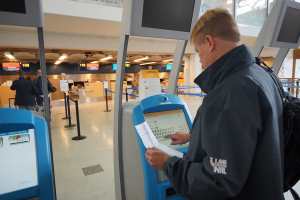Self-Service Design Matters
“You may not have heard of service design yet, but I’d argue that it’s the most important design sub-specialty in the business world today. Service designers create intangible experiences: the series of interactions that you have as you book a flight, pay a bill, get a driver’s license, or go to the doctor…service design is critical to customer experience.” Forrester Research’s Kerry Bodine in her Customer Experience Day post.
Good self-service design is essential to provide a successful customer experience, this post will outline what UX user interface designers can do to ensure that.
Self-service and service design
Self-service is the primary external face of service design, which also covers the back-end processes. In self-service, a customer performs activities in physical and online environments that were previously a seller’s responsibility—they involve no interaction with another human being. Self-service activities are not only online (desktop and mobile). They also include interactions by phone and physical objects such as kiosks, ATMs, and gas pumps. Good usability of a self-service application is paramount, and only possible when self-service design is thoughtful.
Who benefits from self-service?
That depends. TecEd CEO Stephanie Rosenbaum recently co-edited a special IEEE Transactions section on “Designing a Better User Experience for Self-Service Systems.” The editors’ introduction says:
The business advantage [of self-service design] can be considerable. A Dutch bank calculated that a complete redesign of their website, with the aim of making it completely accessible and entirely self-service, reduced the number of contacts with their telephone call center by 15% – 30%. With about 20,000 calls per week and organizational costs of 7.50 – 12.50 Euro per call, the focus on web-based self- service brought the bank a cost reduction of more than 1.7 million Euro per year.
But what about the benefits for users and customers, who often have no choice but to use the self-service system? Both public and private organizations seem to assume that we—the average citizen, client, or customer—can cope with ever-changing self-service systems, and are willing to do so. They offer us the benefit of 24/7 access to an ever-growing range of services and perhaps also a strong sense of autonomy and fulfillment. But in exchange, we — rather than the service providers — have to put in extra effort, as well as losing ‘the human touch’ in the service encounter.
What makes self-service usable or unusable?
How easily—and successfully—can people book flights, pay bills, or renew their drivers’ licenses? As in traditional software applications, successful task flows match users’ mental models (how a user believes something should work). A service designer’s mental model and a user’s mental model may not be the same, which results in users becoming frustrated, losing their way in the process, or dropping off. The self-service design goal is to bridge any gaps between designers’ and users’ mental models, and the best way to accomplish that is to learn from users.
A central premise in self-service design best practice is to learn target users’ goals and tasks to ensure that interactions support what customers want to accomplish.
Insights from users can be gathered with several research methodologies, including user interviews, prototype usability testing, ethnographic field studies, online or intercept surveys, and information architecture (IA) exercises such as card sorting. Which techniques are the best fit to inform self-service design decisions depends on the target audience, the organization’s goals for the service, and the team’s progress in the service design process.
Self-service can fail if human mediation isn’t quickly available as a backup
Some of the best—and worst—examples of self-service design involve processes where the interaction migrates from self-service to human mediation, either to complete the activity or as an “escalation path” to resolve problems by telephone or email. When interactions move smoothly from unattended to attended, the user experience is more likely to be positive. It is important to make transitions between self-service and human interaction as seamless as possible.
These interactions between customer and human mediator can be mined to improve and extend the self-service experience, so that the need for human mediation diminishes over time, saving support costs while providing a great user experience.
Self-Service Design Case Study: Health Insurance Online Application
A major healthcare insurance provider came to TecEd because they were experiencing less than desirable results with their online self-serve application for new plan enrollees:
- Over 40% of the forms were rejected, and they were not meeting their new member business goals
- TecEd launched an iterative research and design process over four weeks; read the case history for details
- In usability walk-throughs, more people rated the redesigned form easy to use
- Outcome: 23% more successful applications were processed without human intervention than the previous form, and plan membership business goals were met
Turn to TecEd for self-service design support to launch self-service applications that provide great user experiences,. We can help with UI and IA design incorporating best practices, expert and user insights. Contact Us and learn how to get started!



